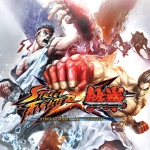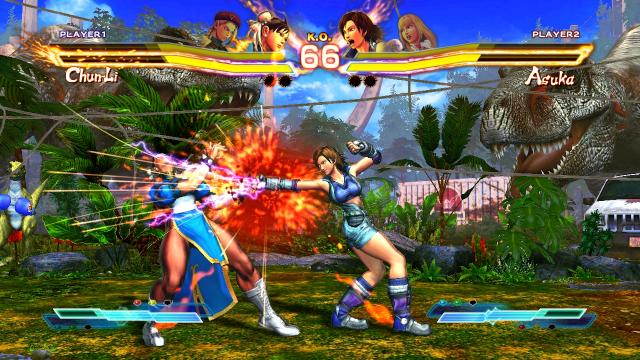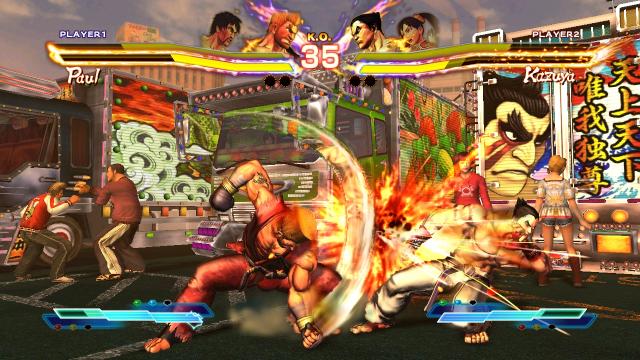
Since Street Fighter X Tekken was announced 18 months ago, fighting game fans have experienced a bit of a roller coaster ride as Capcom slowly revealed more and more characters, game modes and game mechanics. What started out as a seemingly straight forward tag team version of SF4 with an added Tekken roster has grown and morphed into a quite different beast. Many fans have voiced concern (to put it politely) over some of the new game mechanics, whilst others have grown increasingly excited at what they perceive to be systems that will add a new depth and variety to the genre. So which group were right? There’s only one way to find out…FIIIIIIIIIGHT!
Before getting into the nitty-gritty, it’s worth noting that this review is based on the PS3 version of the game. Normally, apart from unnoticeable speed or colouring differences, this wouldn’t be important, but SFxT on the PS3 comes with distinct advantages to its Xbox 360 cousin. Firstly, there are 5 extra characters. Pacman, Megaman, Cole from the Infamous games and Japanese PlayStation mascots Kuro and Toro, are all playable characters, and at least 3 of those will never appear in the Xbox game. They may not be top of everyone’s wishlist for extra fighters, but they are fun and its nice to know they’re there. The second big difference, and probably the more confusing, is that on the PS3 version, you and a friend can team up together on the same console to play matches online against other teams or individuals. For some reason, this isn’t possible on Xbox. Now for me, this isn’t an issue. The chance of my wife telling me to move up, pass the controller and tag me in this instant are minimal, but for those people with like-minded friends, this is a major disappointment. Capcom have seemingly blamed the Microsoft hardware for this omission, but that’s difficult to believe when Mortal Kombat allows you to do exactly the same thing. It’s a strange situation, given the emphasis on 2 player co-op, and you’d really expect this to be patched at some point down the road.
But anyway, enough moaning, what about the gameplay itself? Well, a simplified answer is that it lies somewhere between the precision and balance of SF4, and the madcap explosion that is MVC3. It’s faster and more frantic than SF4, but nowhere near as bat-crap crazy as Marvel. Which is probably why this game is such brilliant fun to play; it really is the best of both worlds. Its fast, without becoming manic, and its strategic, without becoming a cagey standoff. You have to find a balance of attack and defence, and it seems very difficult to play successfully with only one strategy in mind. The Street Fighter half of the roster work pretty much as you’d expect them to, but the Tekken half work in a way somewhere between both franchises. It’s a compromise that works, but hard-core Tekken players may feel like their characters have been hi-jacked slightly. All the fighters move with a similar feel to SF4, but performing combos and the big Super-Art moves has all been overhauled. In many ways its simpler and more friendly to beginners, but it can also become as complex as you are able to make it. The Dan Hibiki-led tutorial is well done and explains all the old and new mechanics clearly, and made everything seem a lot more manageable than I thought it might be. Regular moves, special moves, throws and EX moves all work in exactly the same way as SF4, but there is a veritable kitchen sink load of things to learn on top of that. Super Arts, Cross Arts, Launchers, Charged Specials, Cross Rushes, Cross Assaults, Switch Cancels, Pandora Mode and the Gem System all need learning but, somewhat amazingly, it never seems over-whelming and actually all works pretty intuitively.

The most contentious of the new modes is undoubtedly the Gem System. The storm of fury, disappointment and confusion that exploded on the internet following its announcement was obviously ridiculous, but it’s hard to argue that a few valid points weren’t raised. Players can choose from an enormous list of gems (there are hundreds of them, with more promised as DLC) and attach them to their characters to enhance them in different ways. Once the activation criteria has been met (block 3 times, get hit by 4 special moves, activate Pandora mode etc), the fighter will enjoy a temporary boost in a particular area. You can choose assist gems which might provide you with Auto-block or make pulling off moves easier, or boost gems which might speed you up, increase your damage, increase health, or fill your meter up quicker. It’s a fun sideline which adds a touch of RPGness to proceedings and makes it highly unlikely you’ll ever play someone set up the same as yourself. The problems lie in how to use these when you have a bunch of people round to play together, and in tournament play. Selecting and editing Gem Units takes ages so swapping back and forth between multiple sets is going to take an age. It maybe that a no-gems agreement becomes the norm in tournaments (EVO 2012, the huge fighting game competition in Las Vegas, has already banned them), but for solo online players, it’s an interesting new idea which undoubtedly gives you something extra to think about beyond the character select screen.
SFxT looks great, taking the SF4 template and tweaking the cartoon levels up a couple of notches. The Capcom characters are practically identical to how they were in previous games, and the Tekken characters all look really good, created so that appear just as they did in Tekken 6, but with the OTT comic book presentation of the SF4 series. There is a huge roster of fighters to choose from, and it seems like Capcom have genuinely listened to fan requests with all the obvious candidates present, along with long sought after comebacks from Rolento and Hugo. The backgrounds are also a joy to look at, with so much going on that its almost distracting the first few times you play. Caged Dinosaurs, marauding mammoths, futuristic warzones and busy skateboard parks all fizz away behind the action, and fans of both series will enjoy seeing missing characters crop up in subtle and not so subtle cameos. However, a MAJOR bone of contention is that the 12 extra DLC characters and all the alternative costumes promised for later in the year have turned out to be already on the disc! This means that fans who are keen to play Cody, Elena, Lars, Jack etc are going to have to pay £20 to basically unlock them. Not cool Capcom, not cool.
Music and effects are as sparkly as you’d expect, and follow the cartoon feel of the game perfectly. But it does bring us on to my only serious complaint of the game itself; online play. Lag is still an annoying issue, but it’s not a game –breaker, and after playing copious amounts of SF4 and MVC3 online, you pretty much get used to it. The real problem is a glitch with the sound when playing matches online. As the round starts, the music, and much more importantly, the effects start to fade in and out, move out of synch or disappear altogether. It is extremely off-putting, and anyone who has ever played games like this will testify how important sounds are to help you time moves combos or blocks. Personally, I have yet to play a match on-line without these issues, and although I can’t blame them for me losing any particular match, it certainly doesn’t help and it definitely detracts from the action on screen. Again, hopefully this might be a problem they can patch, but it would be nice if games came complete and ready out of the box.

Other modes work perfectly well though. Arcade is exactly what you expect from a fighting game – a string of increasingly tricky opponents, a bloody annoying boss fight at the end, all wrapped up in a unfathomable story that you don’t care about. Mission mode is more fun, where you work through matches being handicapped by a variety of methods, and trial mode is a useful activity where moves and combos are presented for you to learn, practice and work through. Most fun is Scramble mode, where all 4 characters can be controlled by individual players and are on screen at the same time. Its chaotic, confusing, suffers slow-down from time to time, but it’s amazing fun and as a party game would be a lot more enjoyable than dancing along to Britney and Lady GaGa with a white remote in your hand.
It seems easy to complain about SFxT. The missing content from the Xbox version, the online issues, the dastardly DLC policy and the occasionally troublesome Gem System are certainly disappointing and prevent this game from being scored higher. Some of the roster seems a little unbalanced at present, and you wish there were a few more game modes to keep you going if you’re playing offline by yourself. But when you actually get down to the game’s bread and butter, Player 1 v Player 2, side by side, it’s wonderful. It’s arguably as inclusive to all abilities and play styles as any fighting game has ever been, and the opportunities for real 2 v2 style matches certainly makes SFxT almost entirely unique within its genre. And don’t forget, Capcom rarely get their fighting games right at the first attempt. Street Fighter 3 took 3 updates to perfect, Street Fighter 4 is currently on version number 4, and even the mighty Street Fighter 2 took 5 goes to get it spot on.
So although it’s not without its problems, SFxT is a very good game with the potential to be a great one. You can’t review a game on what it might become, but if there is one thing I’m sure we’ve all learnt from the last 20 years, it’s that Capcom fighting games improve over time. And even without any updates or patches, there is still more than enough here to highly recommend it to anyone with even a passing interest in fighting games. At some point in the future, Namco will release Tekken x Street Fighter, a Tekken based 3-D fighter with the Street Fighter cast involved. It’s going to have to be something very special, with a lot more than just an extra D, to top this.
Reviewed on PS3

Review copy provided by idealo.co.uk

Leave a Reply